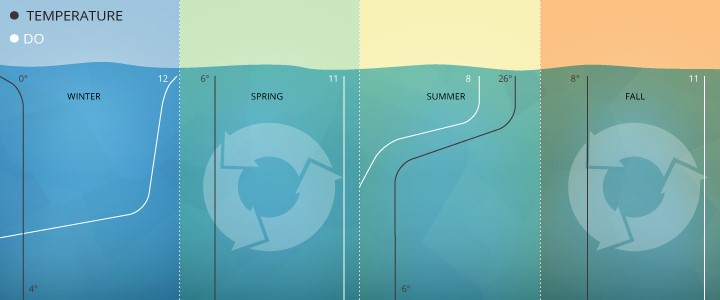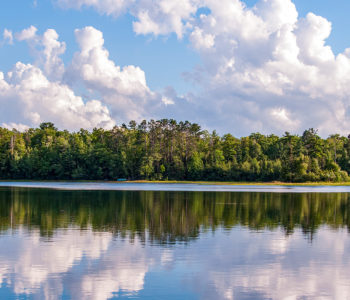 Education
Education
Dissolved Oxygen in Lakes
Similar to the stratifying temperature gradient of any given lake, dissolved oxygen also exhibits a stratified nature that is directly influenced by the lake thermocline, and thus season. Dissolved oxygen refers to the individual molecules of oxygen taken up from the atmosphere and in some areas where groundwater discharge occurs. Rivers and streams tend to have much more dissolved oxygen due to the steady movement of water providing continuous aeration, however lakes contain much less dissolved oxygen due to their stagnant nature. Dissolved oxygen in lakes is primarily dependent on the seasonal thermocline and rate of decomposition that occurs. With regard to the lake thermocline, warmer waters do not hold dissolved oxygen as well as cooler waters. Due to this, lakes tend to lack dissolved oxygen within surface waters during warmer months and accumulate it at greater depths. During the fall and spring, lake turnover will be occurring, in which the thermocline is uniform and allows homogenous mixing of oxygen and nutrients throughout the lake. Although the water is coldest in the winter months, it actually does not hold as much dissolved oxygen as you would think. This is because lakes are typically sealed with a layer of ice at the surface preventing any exposure to the atmosphere and the water beneath tends to be very still. The lack of atmospheric oxygen and aeration by wind that is blocked from the ice causes the water to be deprived of oxygen.
With regard to the rate of decomposition occurring in any given lake, more decomposition will result in lower dissolved oxygen levels. Decomposition is the process by which bacteria breaks down dead organic material into gases and nutrients, which in turn requires consumption of dissolved oxygen. This process usually occurs at the very bottom of lakes where dead organic material has accumulated under the force of gravity, leaving this region of lakes nearly devoid of oxygen. If a lake contains too much vegetation, decomposition of these dead plants can cause an extremely low level of dissolved oxygen and result in fish kill. A common phenomenon of this is eutrophication, where large amounts of nutrients are introduced to a body of water (usually nitrates and phosphorous by land runoff) that perpetuate massive blooms of algae and other vegetation. When these organisms eventually die and sink to the bottom, decomposition quickly uses up all of the available dissolved oxygen and leaves a hypoxic environment for all other organisms.

This is one of a series of three articles written by Abby Good. Abby is a rising senior at the University of Iowa, majoring in Environmental Science with a focus in bioscience and minoring in biology. Her career interests are in conservation and air quality.
References:
Dissolved Oxygen and Water (web reference)
Google Search: dissolved+oxygen+in+lakes
“Lakes Spring Back to Life: The Outside Story.” Center for Northern Woodlands Education








